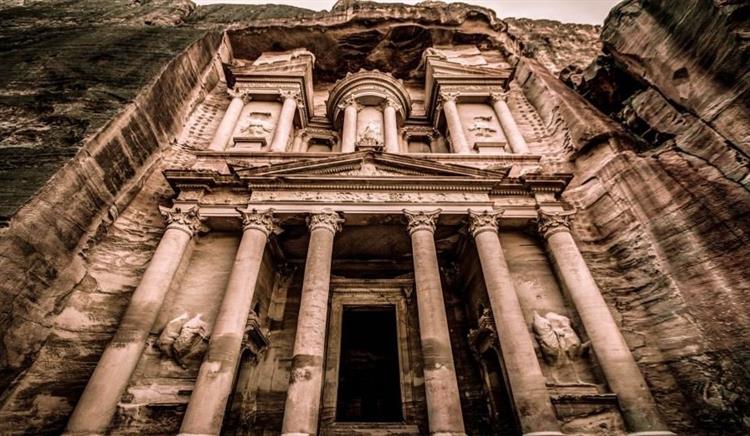Petra Historical City: The Manifestation of Stone Art from Antiquity to the Present
-

-
-
Petra Historical City: The Manifestation of Stone Art from Antiquity to the Present
-
Introduction:
Petra is a complete city, all of which are carved in the mountains and on boulders in red or pink. Hence the name of this beautiful city named Petra. The word Petra in Greek means rock, and because this ancient city is entirely carved in stone, it is called Petra. The ancient name of this city was Sala, meaning the rock, the Romans translated its name into their own language
Petra is a historic city in the Kingdom of Jordan that was the capital of the ancient Nabataean government. This ancient city is located 262 km south of Amman, the capital of Jordan, and to the west is the main road between the city and the port of Aqaba.
Petra was the capital of a powerful government that, with all its boldness, did not allow the invaders to cross that deep rocky valley, and especially resisted the power of the ancient Roman Empire.
From the fourth century to the second century BC, Petra was the capital of the Nebuchadnezzar for 200 years. During this period, Petra reached the peak of its prosperity and civilization.
Nabataeans:
Historians write about the Nabataeans that the tribe most likely originated in southern Saudi Arabia and eventually spread to the Middle East. They made up about 10,000 people who were scattered as Bedouins in the Ara Bah Valley.
The Nabataeans called the desert their homeland and defended its freedom and security with great courage. That's why the merchants were interested in crossing their caravan through this safe desert and drinking water from the Moses spring and visiting it.
Gradually, Petra became a very important trade and commercial route, connecting Syria to the Red Sea and India to the Persian Gulf and the Mediterranean. This position allowed Petra's rulers to turn their capital into an important center for the trade of spices, Indian ivory, Arabic incense, Chinese silk, Egyptian gold, and Finnish pepper.
Thus the nomadic Nabataeans and the Round Desert became urban dwellers who lived in palaces built in the heart of huge boulders and cliffs, and their capital, Petra, was one of the most beautiful and spectacular cities in the ancient world. Petra's dazzling splendor and reputation for wealth eventually drove the Roman Empire into a frenzy, and in 106 AD, the Roman emperor Thera Nuss sent one of his generals with a large army to the Valley of Moses. With the victory of the Romans, Petra became part of the Roman Empire and underwent another period of greatness. The city was gradually evolving, and little by little the characteristics of Nabataean culture disappeared.
Getting out of the hands of the Romans:
In 636, the Arabs were able to save the city of Petra from Roman invasion. Petra residents then engaged in agriculture. But the quake, which struck in 746 and 748, forced Petra residents to relocate. The monuments of this ancient city shine like a stream in the mountains and are a monument from the Neolithic period, which is very spectacular.
In the early nineteenth century (1812), a Swiss traveler named Ludwig Burkehart, nicknamed "Sheikh Ibrahim", set out for Mecca to see the holy city of the Muslims, and was drawn to the "Stone City of Petra". Returning from his tourism, he wrote: "Among the unprotected desert that no traveler can walk, deep in the Valley of Moses, there is one of the most amazing works of ancient art with incredible features."
The report prompted other travelers to take the "Burkehart" route. In 1893, a painter named David Roberts went to Petra and produced beautiful and seemingly beautiful works of the stone that made Petra famous.
This is how Petra was reborn and opened its doors to the people of the world as one of the tourist attractions of the Middle East.
But Petra is in danger of extinction. Sandstorms, rising salt deposits in the rocks and monsoon rains damage Petra's stone buildings, constantly endangering this outstanding human monument.
Petra at UNESCO:
Petra is on the World Heritage List and is one of the Seven New Wonders of the World. That is why a comprehensive effort is being made to save it from destruction.
But erosion factors and their severe effects make any effort difficult.
It is not easy to control passengers and tourists. People who watch Petra are themselves a factor in Petra's devastation. Archaeological studies have used a variety of adhesives that can help strengthen rocks and make them impervious to water.
The wind direction and its destructive power in the Petra region have been measured
To control travelers and limit the number of visitors, measures have been taken by the Ministry of Tourism and Yarmouk University (Jordan) and the Antiquities Organization in the United States.
Despite this, Petra is still in danger, and this red-painted capital built in the heart of the rock by the people who have been forgotten for centuries is now collapsing as fast as it can
-